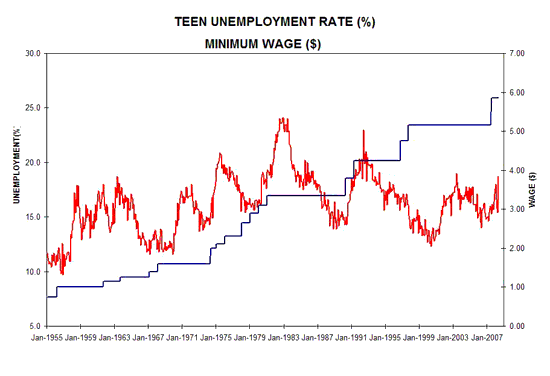Today the federally-mandated minimum wage increases to $7.25 per hour, a 10.7% increase from the previous $6.55 per hour. What effect will the higher wage have on employment and compensation for unskilled workers? That’s a controversial issue.
About a year ago, Angry Bear wrote:
We have a long record to compare the teenage unemployment rate and the minimum wage (see graph above). If you look at the two series you see a very inconsistent record. Sometimes a rise in the minimum wage is followed by a drop in the teenage unemployment rate and sometimes it is followed by a rise in the teenage unemployment rate. Essentially, the correlation between the teenage unemployment rate and changes in the minimum wage is zero, strongly implying that there is no causal relationship.

MP: Let’s assume that there is no correlation between: a) changes in the minimum wage and b) the teenage unemployment rate. That is not the same thing as saying that “the minimum wage has no negative effect on teenage employment.” Here’s why:
Even if the same number of teenage and unskilled workers are employed after a hike in the minimum wage, reflected in NO change in the teen jobless rate (and this is probably not accurate), there are many other adjustments that employers could and will make to offset the monetary increase in hourly labor costs:
1. Fewer Hours – unskilled workers might still be employed, but at a reduced number of hours (the BLS counts workers as “employed” even if they work 1 hour per week, so reduced hours wouldn’t show up in unemployment rates). Full-time workers now become part-time workers. Overtime hours could be eliminated. Full-time restaurant workers now are forced to work a split-shift (e.g. 11 a.m. – 2 p.m. and 5 p.m. – 8 p.m.). Therefore, we would expect a negative relationship between increases in the minimum wage and HOURS WORKED, even if there was no change in either employment levels or the unemployment rate for unskilled workers.
2. Reduced Benefits – employers can easily adjust “total compensation” for unskilled workers and offset higher monetary wages by: a) no longer providing free or discount uniforms and forcing employees to now pay for uniforms, b) no longer providing free or discount food at restaurants, c) reducing or eliminating “employee discounts” on the employer’s merchandise, d) eliminating paid holidays, e) eliminating scholarship programs, f) eliminating group discounts available through large companies like McDonald’s, g) eliminating employer sponsored or subsidized health care benefits, h) eliminating bonuses, i) eliminating company-sponsored holiday parties, etc.
For example, see the list of benefits here for hourly McDonald’s workers in Canada (I couldn’t find a comparable list for the U.S., but I assume the benefits would be pretty similar here), and you’ll see that are at least ten non-monetary benefits offered to even unskilled minimum wage workers at McDonald’s that could be adjusted in the face of higher monetary wage costs resulting from legislated minimum wage increases.
Bottom Line: Demand curves slope downward, and the market for unskilled workers is no exception. Employers WILL respond to increases in the minimum wage, in many ways that will NOT show up in the teenage unemployment rate, but still to the DISADVANTAGE of unskilled workers. The most likely outcome from an increase in the minimum wage to $7.25 per hour will probably be some combination of both increased unemployment for unskilled workers and reductions in compensation.
The laws of supply and demand are not optional. They weren’t enacted by Congress and Congress can’t override them. Minimum-wage laws don’t make low- and unskilled Americans more productive, more experienced, or more desirable. They merely make them more expensive – and more likely, therefore, to be unemployed.
- Bulenox: Get 45% to 91% OFF ... Use Discount Code: UNO
- Risk Our Money Not Yours | Get 50% to 90% OFF ... Use Discount Code: MMBVBKSM
Disclaimer: This page contains affiliate links. If you choose to make a purchase after clicking a link, we may receive a commission at no additional cost to you. Thank you for your support!



Leave a Reply